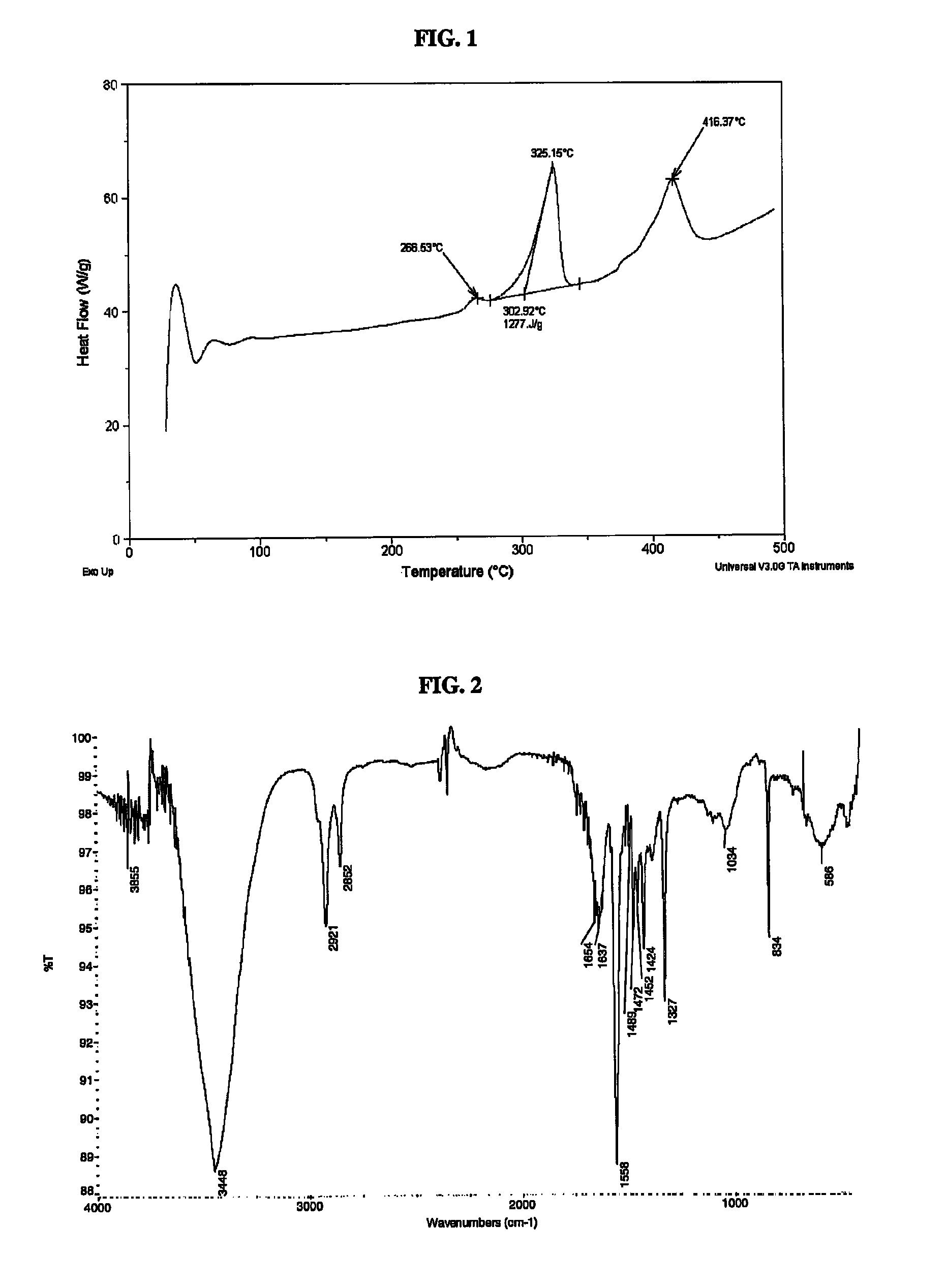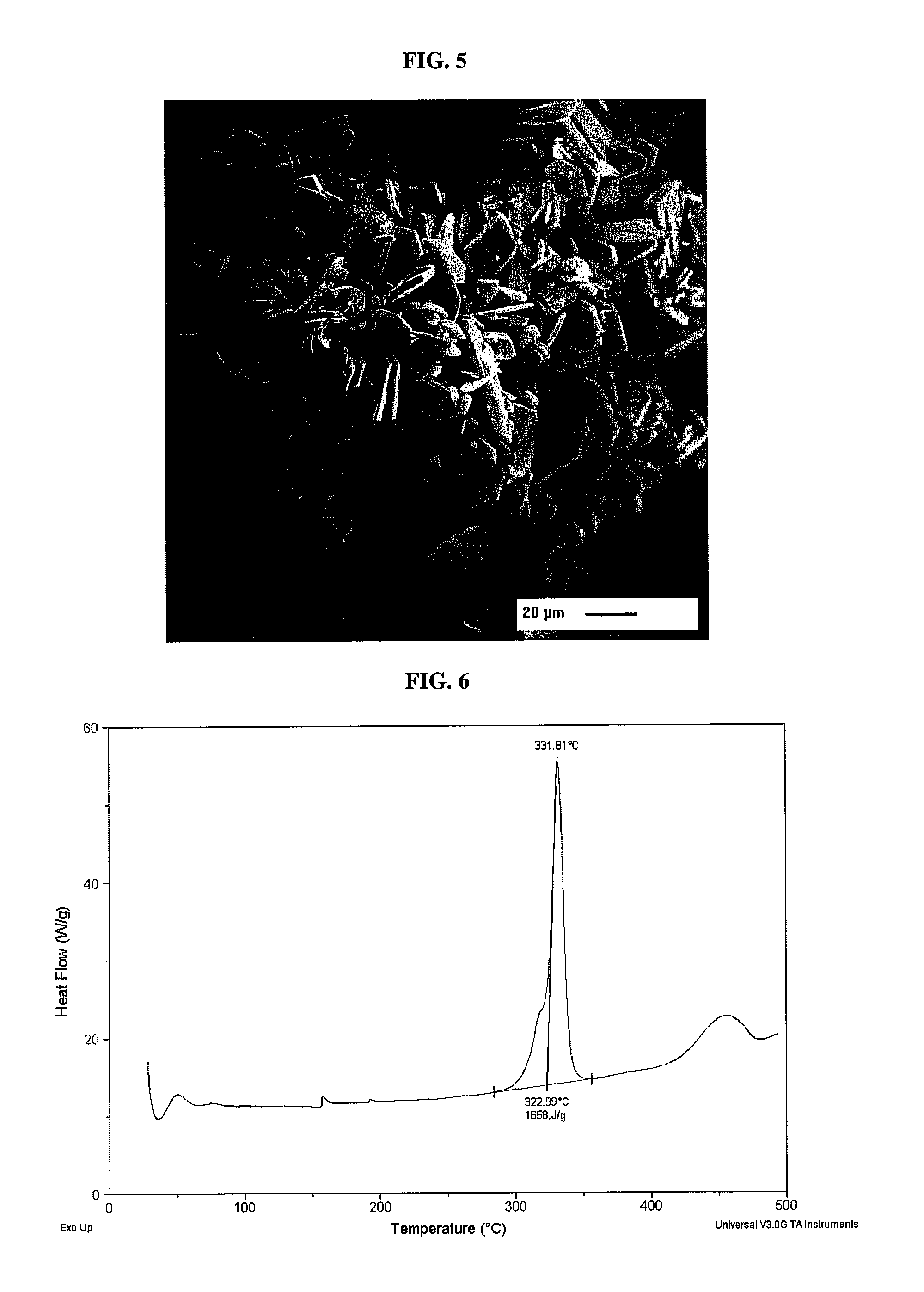Lead-free primary explosive composition and method of preparation
a technology of primary explosives and compositions, applied in the field of primary explosives, can solve the problems of undesirable lead-containing explosives and undesirable for at least some commercial applications
- Summary
- Abstract
- Description
- Claims
- Application Information
AI Technical Summary
Benefits of technology
Problems solved by technology
Method used
Image
Examples
example 1
[0050]Copper(I) nitrotetrazolate was prepared as follows. Cuprous chloride (0.10 g) was suspended in 5 mL of water in a 25 mL Erlenmeyer flask under a nitrogen atmosphere. The mixture was heated to 90° C. on a hot plate with stirring. Sodium 5-nitrotetrazolate dihydrate (0.178 g) was dissolved in 5 mL of water and added to the flask using 2 mL of water to transfer. The solution was stirred at elevated temperature for 5 minutes at which point a small amount of brownish solid had formed. The mixture was stirred with heating for an additional 9 minutes and then the heating was suspended. The resulting brown solid was filtered over Millipore HVLP (0.45 μm) filter paper, washed twice with water, three times with isopropanol and then dried in a convection oven at 70° C.
[0051]The results of a differential scanning calorimetry (DSC) analysis on the solid are shown in FIG. 1. The results of a Fourier Transform Infrared Spectroscopy (FTIR) analysis on the solid are shown in FIG. 2.
example 2
[0052]Copper(I) nitrotetrazolate was prepared as follows. Cuprous chloride (0.90 g, 9.01 mmol) was suspended in 20 mL of water in a 100 mL round bottom flask containing an oval magnetic stir bar. The flask was placed in an oil bath and controlled stirring was started at a rate of 600 RPM. Sodium 5-nitrotetrazolate dihydrate (2.08 g, 1.2 eq.) was dissolved in 20 mL of water and added to the flask. A reflux condenser was placed on the flask and the solution was heated to reflux (approximately 100° C.). The initially green solution turned brown during heating and a brown precipitate formed at or near reflux temperature. The solution was maintained at reflux for about 50 minutes. The flask was removed from the oil bath. The fine, light brown particles were removed by careful decanting and the remaining dark brown material was filtered over Whatman #1 filter paper. The dark brown product was washed three times with water and then three times with isopropanol and afforded a clear filtrate...
example 3
[0062]Copper(I) nitrotetrazolate was prepared as follows. Cuprous chloride (0.901 g, 9.01 mmol) was suspended in 20 mL of water in a 100 mL round bottom flask containing an oval magnetic stir bar. Sodium 5-nitrotetrazolate dihydrate (2.08 g, 1.2 eq.) was dissolved in 20 mL of water and added to the flask. A reflux condenser was placed on the flask and the solution was heated to reflux in a preheated (125° C.) oil bath. The stirring rate was maintained at 300 RPM. The initially dull green solution turned brown during heating and a brown precipitate formed at or near reflux temperature. The solution was maintained at reflux temperature for about 45 minutes. The flask was removed from the oil bath and the solids were allowed to settle. The flask was placed in a ring stand and suspended above a 1 L crystallizing dish. A glass tube (⅛″) was connected to a DI water source using rubber tubing and the tube was inserted into the solids to the bottom the flask. DI water was introduced into th...
PUM
| Property | Measurement | Unit |
|---|---|---|
| temperature | aaaaa | aaaaa |
| temperature | aaaaa | aaaaa |
| molar ratio | aaaaa | aaaaa |
Abstract
Description
Claims
Application Information
 Login to View More
Login to View More - R&D
- Intellectual Property
- Life Sciences
- Materials
- Tech Scout
- Unparalleled Data Quality
- Higher Quality Content
- 60% Fewer Hallucinations
Browse by: Latest US Patents, China's latest patents, Technical Efficacy Thesaurus, Application Domain, Technology Topic, Popular Technical Reports.
© 2025 PatSnap. All rights reserved.Legal|Privacy policy|Modern Slavery Act Transparency Statement|Sitemap|About US| Contact US: help@patsnap.com



